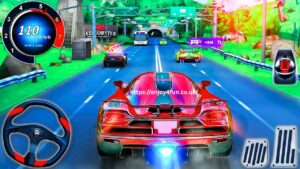Released in 1981, Frogger is a timeless arcade video game that has become a cultural icon. Originally developed by Konami and licensed for North American distribution by Sega/Gremlin, Frogger quickly jumped to popularity for its simple yet highly addictive gameplay. Unlike the space shooters dominating the arcades of the era, Frogger introduced a unique concept: help a frog cross a hazardous road and river to get home safely.
Over the decades, Frogger has seen countless remakes, adaptations, and references across pop culture. Despite its simple premise, the game is still fondly remembered and widely played today.
The Origins of Frogger
Frogger was designed by Toru Iwatani, the same developer behind Pac-Man, although the official credit for design goes to Akira Hashimoto. The game’s development stemmed from the idea of a non-violent, environmentally themed game that could appeal to all ages.
Konami saw the potential in creating a game that stood out from the increasingly violent and space-themed titles. With Froger’s bright visuals, charming characters, and easily understandable objectives, it appealed to both casual and serious gamers.
Frogger Gameplay Simple, Challenging, and Addictive
The beauty of Frogger lies in its elegant simplicity. The player controls a frog that must reach its home at the top of the screen by navigating a series of hazardous obstacles.
Gameplay Overview
- Controls: The frog moves in four directions – up, down, left, and right.
- Objective: Guide five frogs from the bottom to the top of the screen into one of the designated “frog homes.”
- Obstacles
- Road Traffic: Cars, buses, and racing vehicles in the lower half of the screen.
- River Hazards: Floating logs, turtles (some of which dive underwater), and crocodiles in the upper half.
- Time Limit: Each frog must reach home before time runs out.
Players must time their jumps with precision to avoid getting squashed or falling into the water. As the levels progress, the difficulty ramps up, increasing the speed and frequency of obstacles.
Froger’s Place in Arcade History
Froger was one of the most successful arcade games of the early 1980s, earning millions in revenue and solidifying Konami’s place in the industry. It was notable for being one of the first games to feature a dual-direction scrolling screen – the road section scrolls left to right, while the river scrolls in the opposite direction.
In its first year alone, Froger sold over 20,000 arcade cabinets in the U.S. and became a fixture in arcades, pizza parlors, and convenience stores across the country.
Cultural Impact
- Frogger appeared on the Atari 2600, Commodore 64, Apple II, and later, home consoles like the Sega Genesis and Super Nintendo.
- It featured prominently in the Seinfeld episode “The Frogger,” where George Costanza tries to preserve his high score on a Frogger cabinet.
- Numerous spin-offs and reimaginings have followed, including Frogger 3D, Frogger: The Great Quest, and mobile versions.
Why Frogger Remains Popular Today
- 1. Universal Appeal
Frogger’s concept is relatable and age-agnostic. There’s no violence, no complex narrative, just skillful timing and simple controls. This makes it a perfect game for kids and adults alike.
- 2. High Replay Value
With its escalating difficulty and short levels, Froger is easy to pick up but hard to master. This formula encourages repeat play, which is a hallmark of successful arcade design.
- 3. Nostalgia Factor
Gamers who grew up in the 1980s and 1990s often return to Froger for a hit of nostalgia. Its distinctive music and sound effects are instantly recognizable.
- 4. Modern Availability
Froger is widely accessible on modern platforms. You can find Froger on:
- Mobile Devices (iOS & Android)
- Online Browsers
- Consoles via emulation or digital stores
- Remastered Editions on PlayStation and Xbox
Top Frogger Versions & Remakes
While the original arcade game remains iconic, several notable remakes and versions deserve a mention:
Frogger (1997 – PlayStation/PC)
This version added 3D graphics and more challenging levels but retained the original concept. It became a commercial success and introduced Frogger to a new generation.
Frogger: Hyper Arcade Edition (2012)
Released for multiple platforms including Xbox Live Arcade and PlayStation Network, this version includes updated visuals, multiplayer modes, and even themed skins like Castlevania.
Frogger in Toy Town (2019 – Apple Arcade)
A modern reimagining of the game with stunning visuals, physics-based obstacles, and updated gameplay. It introduced younger audiences to the classic while maintaining the spirit of the original.
Frogger and the Rumbling Ruins (2022)
Another Apple Arcade exclusive, this game adds a puzzle-adventure element, marking a fresh direction for the franchise.
Tips and Tricks for Mastering Frogger
- Focus on the Patterns: Vehicles and logs follow fixed patterns. Observe before jumping.
- Use the Edge: Frogger can hang partially off logs and still survive. Use this to your advantage.
- Watch the Turtles: Some turtles submerge. Don’t stay on them too long.
- Avoid Greed: Going for bonus flies is risky. Focus on survival, especially in higher levels.
- Plan Ahead: Don’t jump aimlessly. Always plan two or three hops ahead to avoid dead ends.
Froger in Modern Pop Culture
Froger has made appearances in movies, TV shows, and even music videos. It has been referenced in:
- Wreck-It Ralph
- Ready Player One
- Family Guy
- Robot Chicken
Its legacy is maintained not just through official games but also through fan-made versions and endless homages in modern indie games.
Conclusion
Frogger is more than just a video game—it’s a piece of gaming history. Its unique blend of challenge, charm, and simplicity has cemented its place as one of the greatest arcade games of all time. Whether you’re playing the original cabinet, a modern mobile version, or a 3D remake, Froger continues to deliver that timeless fun that made it a legend.
As gaming continues to evolve, titles like Froger remind us that you don’t need flashy graphics or complex mechanics to create something truly unforgettable. All you need is a frog, a busy road, and the determination to hop to safety.






